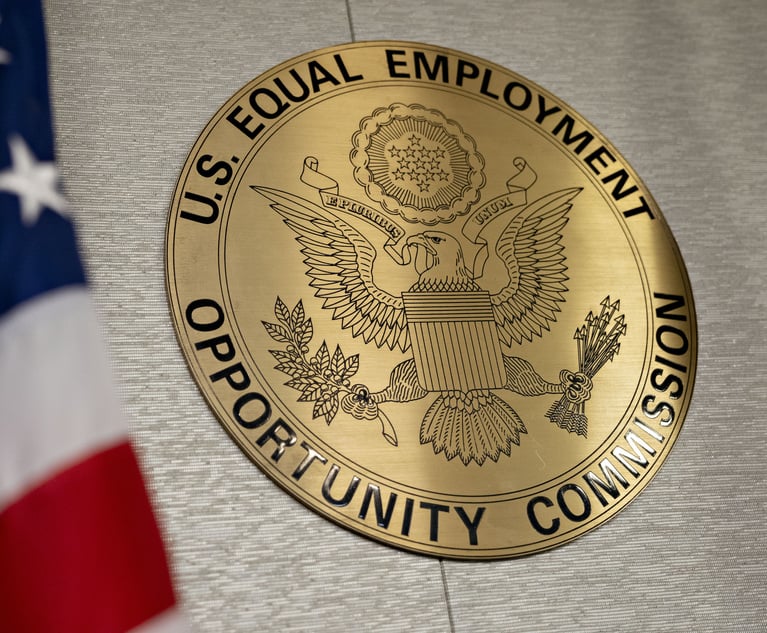Supreme Court Offers Companies Pension Liability Relief
Employers dodged a high-powered bullet in mid-June when a unanimous Supreme Court overturned the 9th Circuit Court of Appeals' decision in Beck v. PACE International Union.
July 31, 2007 at 08:00 PM
5 minute read
Employers dodged a high-powered bullet in mid-June when a unanimous Supreme Court overturned the 9th Circuit Court of Appeals' decision in Beck v. PACE International Union. The decision means companies opting to terminate an ERISA pension plan do not have to consider invitations to merge the plan with a union pension fund as an alternative to termination. Merging a plan often means the original plan sponsor forfeits any pension surpluses.
“The implications of the 9th Circuit's decision would have been pretty bad because it suggested the implementation of administrative decisions, even if they were [sponsor] functions of employers, invoked a fiduciary duty,” says Heidi Winzeler, counsel at Osler Hoskin & Harcourt.
The 9th Circuit decision shocked ERISA practitioners and the benefits industry. Before Beck, the industry firmly believed employers could terminate fully funded or overfunded pension plans by following the process described in ERISA, which releases employers from their obligations under terminated plans if they purchase an annuity or pay a lump sum that replaces the pension benefits.
“What employers liked about ERISA is that it was a clear statute that identified their risk by making it plain what they could and could not do in pension plan terminations,” says Peter Goodman, a partner at Andrews Kurth.
Until the Supreme Court ruling, however, a novel argument by union lawyers threatened to undermine that certainty.
Disaster Averted
When Crown Vantage Inc., a Cincinatti-based paper products manufacturer, filed for bankruptcy in 2000, it also decided to terminate its pension plan. The company's intention was to purchase annuities to replace the benefits–a course of action that ERISA specifically permits.
Terminating the plan gave Crown's creditors access to the $5 million surplus that existed in the fund. PACE, however, had its own designs on the money. It proposed Crown merge its plan with PACE's multiemployer fund, a course of action that would have funneled the surplus into PACE's fund.
When Crown rejected the proposal, the union filed an action in bankruptcy court alleging that Crown's directors had breached their fiduciary duties under ERISA by failing to give diligent consideration to the merger.
The bankruptcy court agreed with PACE and issued an injunction preventing Crown from obtaining the surplus. The District Court upheld the ruling, as did the 9th Circuit.
The appeals court reasoned that the decision to terminate the plan was not subject to ERISA's fiduciary obligations. But it also concluded that “the implementation of a decision to terminate” was fiduciary in nature. This meant that Crown had a fiduciary obligation to consider the merger seriously, which it had failed to do.
In the Supreme Court, Justice Antonin Scalia, who wrote the judgment, sidestepped the fiduciary issue. Vantage had no obligation to consider the merger, he concluded, because merger was an alternative to rather than a method of termination.
“Merger is fundamentally different [from termination],” Scalia stated. “It represents a continuation rather than a cessation of the ERISA regime.”
Deciding otherwise, Scalia noted, would put the court at odds with the Pension Benefit Guaranty Corporation (PBGC), which administers the federal insurance program that protects plan benefits. The PBGC's position was that ERISA didn't permit merger as a method of termination because it was in fact an alternative to termination.
“We have traditionally deferred to the PBGC when interpreting ERISA,” Scalia wrote, “for to attempt to answer these questions without the view of the agencies responsible for enforcing ERISA would be to embark upon a voyage without a compass.”
Scalia wrote that the court would defer to the PBGC's interpretation of the law as long as the interpretation was reasonable. The Court's finding that the agency's interpretation was reasonable should have been the end of it.
“Scalia could have stopped after reaching the conclusion that a merger was not a termination,” says Nell Hennessy, president and CEO of Fiduciary Counselors Inc., a consultancy.
His failure to do so leaves some important issues up in the air.
Lingering Issues
The greatest uncertainty arises from a footnote in the judgment, in which Scalia observes “Crown … could have drafted its plan documents to limit the available methods of termination, so that merger was not permitted.”
The observation is surprising in light of the court's finding that ERISA precluded merger as a means of terminating a plan.
“So the question is how far we take this footnote,” Winzeler says. “Does it suggest there's still room for argument that a merger is permissible unless specifically precluded by the plan?”
Winzeler believes that a plan allowing termination by merger would offend ERISA and be void. “But that still takes us back to why footnote 3 is in the judgment,” she says.
Hennessy opines that plan drafters will have to consider whether to “draft defensively” by clarifying that merger is prohibited as a form of termination in the plan language.
“People may start putting something about that in plans as a cautionary measure,” she says.
However, that wouldn't have helped anyone get around the broader implications had the Supreme Court upheld the 9th Circuit. Thankfully, this didn't happen.
“Despite some lingering concerns, the benefits community can sleep peacefully in the knowledge that they can continue to do things as they have always done, the insurance companies can go ahead and issue their annuities and the world will be a safer place,” Goodman says.
This content has been archived. It is available through our partners, LexisNexis® and Bloomberg Law.
To view this content, please continue to their sites.
Not a Lexis Subscriber?
Subscribe Now
Not a Bloomberg Law Subscriber?
Subscribe Now
NOT FOR REPRINT
© 2025 ALM Global, LLC, All Rights Reserved. Request academic re-use from www.copyright.com. All other uses, submit a request to [email protected]. For more information visit Asset & Logo Licensing.
You Might Like
View All

‘Extremely Disturbing’: AI Firms Face Class Action by ‘Taskers’ Exposed to Traumatic Content
5 minute read
In-House Lawyers Are Focused on Employment and Cybersecurity Disputes, But Looking Out for Conflict Over AI
Trending Stories
- 1The Rise and Risks of Merchant Cash Advance Debt Relief Companies
- 2Ill. Class Action Claims Cannabis Companies Sell Products with Excessive THC Content
- 3Suboxone MDL Mostly Survives Initial Preemption Challenge
- 4Paul Hastings Hires Music Industry Practice Chair From Willkie in Los Angeles
- 5Global Software Firm Trying to Jump-Start Growth Hands CLO Post to 3-Time Legal Chief
Who Got The Work
J. Brugh Lower of Gibbons has entered an appearance for industrial equipment supplier Devco Corporation in a pending trademark infringement lawsuit. The suit, accusing the defendant of selling knock-off Graco products, was filed Dec. 18 in New Jersey District Court by Rivkin Radler on behalf of Graco Inc. and Graco Minnesota. The case, assigned to U.S. District Judge Zahid N. Quraishi, is 3:24-cv-11294, Graco Inc. et al v. Devco Corporation.
Who Got The Work
Rebecca Maller-Stein and Kent A. Yalowitz of Arnold & Porter Kaye Scholer have entered their appearances for Hanaco Venture Capital and its executives, Lior Prosor and David Frankel, in a pending securities lawsuit. The action, filed on Dec. 24 in New York Southern District Court by Zell, Aron & Co. on behalf of Goldeneye Advisors, accuses the defendants of negligently and fraudulently managing the plaintiff's $1 million investment. The case, assigned to U.S. District Judge Vernon S. Broderick, is 1:24-cv-09918, Goldeneye Advisors, LLC v. Hanaco Venture Capital, Ltd. et al.
Who Got The Work
Attorneys from A&O Shearman has stepped in as defense counsel for Toronto-Dominion Bank and other defendants in a pending securities class action. The suit, filed Dec. 11 in New York Southern District Court by Bleichmar Fonti & Auld, accuses the defendants of concealing the bank's 'pervasive' deficiencies in regards to its compliance with the Bank Secrecy Act and the quality of its anti-money laundering controls. The case, assigned to U.S. District Judge Arun Subramanian, is 1:24-cv-09445, Gonzalez v. The Toronto-Dominion Bank et al.
Who Got The Work
Crown Castle International, a Pennsylvania company providing shared communications infrastructure, has turned to Luke D. Wolf of Gordon Rees Scully Mansukhani to fend off a pending breach-of-contract lawsuit. The court action, filed Nov. 25 in Michigan Eastern District Court by Hooper Hathaway PC on behalf of The Town Residences LLC, accuses Crown Castle of failing to transfer approximately $30,000 in utility payments from T-Mobile in breach of a roof-top lease and assignment agreement. The case, assigned to U.S. District Judge Susan K. Declercq, is 2:24-cv-13131, The Town Residences LLC v. T-Mobile US, Inc. et al.
Who Got The Work
Wilfred P. Coronato and Daniel M. Schwartz of McCarter & English have stepped in as defense counsel to Electrolux Home Products Inc. in a pending product liability lawsuit. The court action, filed Nov. 26 in New York Eastern District Court by Poulos Lopiccolo PC and Nagel Rice LLP on behalf of David Stern, alleges that the defendant's refrigerators’ drawers and shelving repeatedly break and fall apart within months after purchase. The case, assigned to U.S. District Judge Joan M. Azrack, is 2:24-cv-08204, Stern v. Electrolux Home Products, Inc.
Featured Firms
Law Offices of Gary Martin Hays & Associates, P.C.
(470) 294-1674
Law Offices of Mark E. Salomone
(857) 444-6468
Smith & Hassler
(713) 739-1250







